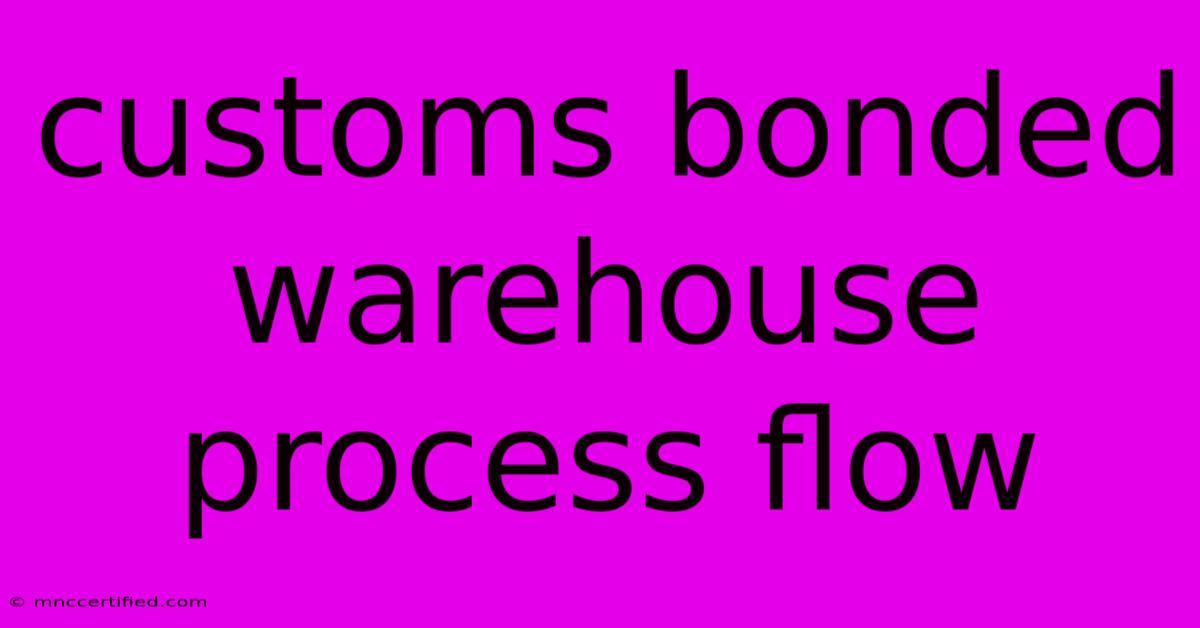Customs Bonded Warehouse Process Flow

Table of Contents
Customs Bonded Warehouse Process Flow: A Step-by-Step Guide
In the global trade landscape, customs bonded warehouses play a crucial role in streamlining import and export operations. These secure facilities offer businesses a flexible and cost-effective way to manage their goods while they're in transit. Understanding the customs bonded warehouse process flow is essential for importers, exporters, and businesses involved in international trade.
This comprehensive guide will walk you through each step of the process, providing clarity on how goods are handled within a bonded warehouse, ensuring compliance with customs regulations, and ultimately contributing to smoother international trade.
What is a Customs Bonded Warehouse?
A customs bonded warehouse is a designated facility under the control of customs authorities where imported or exported goods can be stored, processed, or manipulated without paying import duties or taxes until they are released for consumption or re-export.
Customs Bonded Warehouse Process Flow
The process flow within a customs bonded warehouse can be broken down into the following key steps:
1. Goods Arrival and Declaration:
- Importation: When imported goods arrive at a port or airport, they are transported to the bonded warehouse. The importer must declare the goods to customs authorities, providing details like the nature of the goods, quantity, value, origin, and intended use.
- Exportation: Similarly, goods destined for export can be brought into a bonded warehouse for processing or repackaging before shipment. The exporter must declare the goods to customs authorities.
2. Customs Examination and Approval:
- Customs officials conduct physical inspections of the goods to verify the accuracy of the declaration and ensure compliance with import/export regulations.
- The goods may be subjected to various tests and analyses depending on their nature.
- Once the examination is complete, customs authorities authorize the goods to be stored within the bonded warehouse.
3. Storage and Handling:
- The bonded warehouse operator takes responsibility for the secure storage and handling of the goods.
- Goods can be stored for an extended period, allowing businesses to manage their inventory and optimize their supply chain.
- Various operations within the warehouse can be performed, such as repackaging, labeling, and value-adding activities.
4. Processing and Manipulation:
- Customs bonded warehouses can accommodate various processing activities, including:
- Repackaging: Re-packaging goods in different containers for easier distribution.
- Labeling: Applying appropriate labels according to destination and regulations.
- Assembly: Assembling components into finished products.
- Mixing and Blending: Combining different ingredients to create new products.
- Quality Control: Ensuring goods meet required standards.
5. Duty Payment and Release:
- When goods are ready for release, the importer or exporter pays the applicable import duties or taxes.
- The importer/exporter provides customs authorities with the required documentation, including the original bill of lading, invoice, and other necessary paperwork.
- Customs officials clear the goods for release and they are then transported to their final destination.
6. Re-exportation:
- If the goods are destined for re-export, the importer or exporter must provide customs authorities with proof of export.
- The goods are then released from the bonded warehouse and shipped to the designated destination.
Benefits of Using a Customs Bonded Warehouse:
- Reduced Import Duties and Taxes: Businesses can defer duty payment until the goods are released for consumption, which provides flexibility and cost savings.
- Simplified Customs Procedures: Bonded warehouses streamline customs processes, reducing the time and effort required for clearance.
- Inventory Management and Flexibility: Businesses can store goods for extended periods, manage inventory effectively, and respond to market changes quickly.
- Value-Adding Activities: Processing and manipulation of goods within the warehouse can enhance their value before they are released for consumption.
- Protection from Duties on Re-exported Goods: Goods can be processed and then re-exported without incurring import duties or taxes.
Key Considerations for Choosing a Bonded Warehouse:
- Location: Choose a bonded warehouse strategically located near ports, airports, or your business operations.
- Services: Consider the specific services offered by the warehouse, such as processing, repackaging, and inventory management.
- Security: Ensure the warehouse meets high security standards to protect your goods from theft and damage.
- Compliance: The warehouse should comply with all customs regulations and relevant legislation.
- Cost: Compare pricing models and ensure the warehouse offers competitive rates.
Conclusion:
Understanding the customs bonded warehouse process flow is crucial for any business engaged in international trade. By utilizing these facilities, companies can effectively manage their import/export operations, reduce costs, optimize their supply chain, and gain a competitive advantage in the global marketplace. The benefits of bonded warehouses extend beyond simply storing goods, enabling businesses to streamline their operations, gain flexibility, and ultimately, drive growth through more efficient international trade.

Thank you for visiting our website wich cover about Customs Bonded Warehouse Process Flow. We hope the information provided has been useful to you. Feel free to contact us if you have any questions or need further assistance. See you next time and dont miss to bookmark.
Featured Posts
-
When Does Arcane Season 2 Premiere On Netflix
Nov 10, 2024
-
Companies Like Duluth Trading Company
Nov 10, 2024
-
Najmul Hossain Shines Afghanistan Vs Bangladesh 2nd Odi
Nov 10, 2024
-
Assurity Disability Insurance Reviews
Nov 10, 2024
-
Real Madrid Vs Osasuna La Liga Livestream Guide
Nov 10, 2024